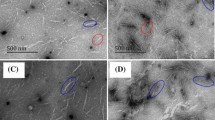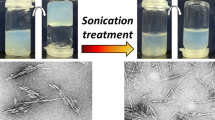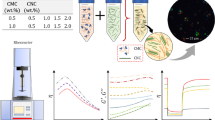Abstract
Cellulose nanocrystals (NCC) are produced through acidic hydrolysis and mechanical disintegration of cellulose. Plans to produce NCC on an industrial scale point to the need for an efficient method to characterize its suspensions. Viscosity is a bulk property that could be used for this characterization since it accurately describes the suspension and the inherent properties of the nanocrystals. Our objective was to develop a convenient way to characterize diluted aqueous NCC suspensions without the need of complex instrumentation. The viscosity of dilute suspensions was measured with an automated rolling ball viscometer, which requires only a small amount of sample. The feasibility of the proposed procedure was confirmed by using dextran solutions as standards. The NCC suspensions were characterized by their intrinsic viscosity [η], which is directly related to the hydrodynamic dimensions of the nanocrystals. The data obtained were analyzed using the equations established by Huggins and by Fedors. Fedors’ approach gave more accurate results, leading to a value of 213 mL g−1 for the intrinsic viscosity, [η]. The non-Newtonian character of NCC suspensions at increasing concentrations was evaluated.







Similar content being viewed by others
References
Agoda-Tandjawa G, Durand S, Berot S, Blassel C, Gaillard C, Garnier C, Doublier JL (2010) Rheological characterization of microfibrillated cellulose suspensions after freezing. Carbohydr Polym 80(3):677–686
AMVn automated viscometer (2008) Instruction manual. Anton Paar, Austria
Antoniou E, Buitrago CF, Tsianou M, Alexandridis P (2010) Solvent effects on polysaccharide conformation. Carbohydr Polym 79(2):380–390
Araki J, Wada M, Kuga S, Okano T (1998) Flow properties of microcrystalline cellulose suspension prepared by acid treatment of native cellulose. Colloids Surf A-Physicochem Eng Asp 142(1):75–82
Araki J, Wada M, Kuga S, Okana T (1999) Influence of surface charge on viscosity behavior of cellulose microcrystal suspension. J Wood Sci 45(3):258–261
Bagchi A, Chhabra RP (1991) Rolling ball viscometry for Newtonian and power law liquids. Chem Eng Process 30(1):11–13
Beck-Candanedo S, Roman M, Gray DG (2005) Effect of reaction conditions on the properties and behavior of wood cellulose nanocrystal suspensions. Biomacromolecules 6(2):1048–1054
Bercea M, Navard P (2000) Shear dynamics of aqueous suspensions of cellulose whiskers. Macromolecules 33(16):6011–6016
Boluk Y, Lahiji R, Zhao LY, McDermott MT (2011) Suspension viscosities and shape parameter of cellulose nanocrystals (CNC). Colloids Surf A-Physicochem Eng Asp 377(1–3):297–303
Chhabra R, Richardson JF (2008) Non-Newtonian flow and applied rheology engineering applications. Butterworth-Heinemann/Elsevier, Amsterdam
Dong XM, Kimura T, Revol JF, Gray DG (1996) Effects of ionic strength on the isotropic-chiral nematic phase transition of suspensions of cellulose crystallites. Langmuir 12(8):2076–2082
Fedors RF (1979) An equation suitable for describing the viscosity of dilute to moderately concentrated polymer solutions. Polymer 20(2):225–228
Gericke M, Schlufter K, Liebert T, Heinze T, Budtova T (2009) Rheological properties of cellulose/ionic liquid solutions: from dilute to concentrated states. Biomacromolecules 10(5):1188–1194
Habibi Y, Lucia LA, Rojas OJ (2010) Cellulose nanocrystals: chemistry, self-assembly, and applications. Chem Rev 110(6):3479–3500
Hasani M, Cranston ED, Westman G, Gray DG (2008) Cationic surface functionalization of cellulose nanocrystals. Soft Matter 4(11):2238–2244
Intrinsic viscosity, molar mass, and K value of polymers in dilute solution (2008) Application note. Anton Paar, Austria
Klemm D, Kramer F, Moritz S, Lindström T, Ankerfors M, Gray D, Dorris A (2011) Nanocelluloses: a new family of nature-based materials. Angew Chem Int Ed 50(24):5438–5466
Kulicke W-M (2004) Viscosimetry of polymers and polyelectrolytes. Springer, Berlin
Lasseuguette E, Roux D, Nishiyama Y (2008) Rheological properties of microfibrillar suspension of TEMPO-oxidized pulp. Cellulose 15(3):425–433
Lima MMD, Borsali R (2004) Rodlike cellulose microcrystals: structure, properties, and applications. Macromol Rapid Commun 25(7):771–787
Ma J, Liang B, Cui P, Dai H, Huang R (2003) Dilute solution properties of hydrophobically associating polyacrylamide: fitted by different equations. Polymer 44(4):1281–1286
Moon RJ, Martini A, Nairn J, Simonsen J, Youngblood J (2011) Cellulose nanomaterials review: structure, properties and nanocomposites. Chem Soc Rev 40(7):3941–3994
Revol JF, Bradford H, Giasson J, Marchessault RH, Gray DG (1992) Helicoidal self-ordering of cellulose microfibrils in aqueous suspension. Int J Biol Macromol 14(3):170–172
Revol JF, Godbout L, Dong XM, Gray DG, Chanzy H, Maret G (1994) Chiral nematic suspensions of cellulose crystallites—phase separation and magnetic field orientation. Liq Cryst 16(1):127–134
Schoff CK, Kamarchik P (2005) Rheology and rheological measurements. In: Kirk-Othmer Encyclopedia of Chemical Technology. Wiley, New York. doi:10.1002/0471238961.1808051519030815.a01.pub2
Šesták J, Ambros F (1973) On the use of the rolling-ball viscometer for the measurement of rheological parameters of power law fluids. Rheol Acta 12(1):70–76
Tirtaatmadja V, Dunstan DE, Roger DV (2001) Rheology of dextran solutions. J Nonnewton Fluid Mech 97(2–3):295–301
Ureña-Benavides EE, Ao G, Davis VA, Kitchens CL (2011) Rheology and phase behavior of lyotropic cellulose nanocrystal suspensions. Macromolecules 44:8990–8998
van Voorst C, van Duijn C (1976) An improved and simplified design for a Hoeppler-type (rolling ball) microviscometer. J Phys E: Sci Instrum 9:613–615
Acknowledgments
We thank NSERC for support, and FPInnovations for a sample of NCC aqueous suspension. Thanks to Dr. Elisabeth Kloser for conductometric titration of the NCC suspension.
Author information
Authors and Affiliations
Corresponding author
Rights and permissions
About this article
Cite this article
González-Labrada, E., Gray, D.G. Viscosity measurements of dilute aqueous suspensions of cellulose nanocrystals using a rolling ball viscometer. Cellulose 19, 1557–1565 (2012). https://doi.org/10.1007/s10570-012-9746-9
Received:
Accepted:
Published:
Issue Date:
DOI: https://doi.org/10.1007/s10570-012-9746-9




